Desmopressin Acetate
Prasco Laboratories
Ferring Pharmaceuticals Inc.
Desmopressin Acetate Nasal Spray, 10 mcg per 0.1 mL
FULL PRESCRIBING INFORMATION: CONTENTS*
- DESMOPRESSIN ACETATE DESCRIPTION
- CLINICAL PHARMACOLOGY
- DESMOPRESSIN ACETATE INDICATIONS AND USAGE
- DESMOPRESSIN ACETATE CONTRAINDICATIONS
- WARNINGS
- PRECAUTIONS
- DESMOPRESSIN ACETATE ADVERSE REACTIONS
- OVERDOSAGE
- DESMOPRESSIN ACETATE DOSAGE AND ADMINISTRATION
- HOW SUPPLIED
- PRINCIPAL DISPLAY PANEL - 5 mL Bottle Carton
FULL PRESCRIBING INFORMATION
Rx only
DESMOPRESSIN ACETATE DESCRIPTION
Desmopressin Acetate Nasal Spray is a synthetic analogue of the natural pituitary hormone 8-arginine vasopressin (ADH), an antidiuretic hormone affecting renal water conservation. It is chemically defined as follows:
Mol. wt. 1183.34
Empirical formula: C46H64N14O12S2•C2H4O2•3H2O

1-(3-mercaptopropionic acid)-8-D-arginine vasopressin monoacetate (salt) trihydrate.
Desmopressin Acetate Nasal Spray is provided as an aqueous solution for intranasal use.
Each mL contains:
Desmopressin acetate 0.1 mg
Sodium chloride 7.5 mg
Citric acid monohydrate 1.7 mg
Disodium phosphate dihydrate 3 mg
Benzalkonium chloride solution (50%) 0.2 mg
The Desmopressin Acetate Nasal Spray compression pump delivers 0.1 mL (10 mcg) of desmopressin acetate per spray.
CLINICAL PHARMACOLOGY
Desmopressin acetate contains as active substance 1-(3-mercaptopropionic acid)-8-D-arginine vasopressin, which is a synthetic analogue of the natural hormone arginine vasopressin. One mL (0.1 mg) of intranasal desmopressin acetate has an antidiuretic activity of about 400 International Units (IU); 10 mcg of desmopressin acetate is equivalent to 40 IU. The change in structure of arginine vasopressin to desmopressin acetate has resulted in a decreased vasopressor action and decreased actions on visceral smooth muscle relative to the enhanced antiduretic activity, so that clinically effective antiduretic doses are usually below threshold levels for effects on vascular or visceral smooth muscle.
Desmopressin acetate administered intranasally has an antiduretic effect about one-tenth that of an equivalent dose administered by injection.
Pharmacokinetics
Intranasal Desmopressin Acetate is absorbed from the nasal mucosa. Desmopressin Acetate exhibits a biphasic elimination profile, with half-lives of 7.8 and 75.5 minutes for the initial and terminal phases, respectively, in contrast to lysine vasopressin, which has initial and terminal phase half-lives of 2.5 and 14.5 minutes, respectively. Desmopressin Acetate is mainly excreted in the urine. A pharmacokinetic study conducted in healthy volunteers and patients with mild, moderate, and severe renal impairment (n=24, 6 subjects each group) receiving single dose Desmopressin Acetate (2 mcg) injection demonstrated a difference in Desmopressin Acetate half-life. Terminal half-life significantly increased from 3 hours in normal healthy patients to 9 hours in patients with severe renal impairment. [See CONTRAINDICATIONS.]
DESMOPRESSIN ACETATE INDICATIONS AND USAGE
Central Cranial Diabetes Insipidus
Desmopressin Acetate Nasal Spray is indicated as antidiuretic replacement therapy in the management of central cranial diabetes insipidus and for management of the temporary polyuria and polydipsia following head trauma or surgery in the pituitary region. It is ineffective for the treatment of nephrogenic diabetes insipidus.
The use of Desmopressin Acetate Nasal Spray in patients with an established diagnosis will result in a reduction in urinary output with increase in urine osmolality and a decrease in plasma osmolality. This will allow the resumption of a more normal life-style with decrease in urinary frequency and nocturia.
There are reports of an occasional change in response with time, usually greater than 6 months. Some patients may show a decreased responsiveness, others a shortened duration of effect. There is no evidence this effect is due to the development of binding antibodies but may be due to a local inactivation of the peptide.
Patients are selected for therapy by establishing the diagnosis by means of the water deprivation test, the hypertonic saline infusion test, and/or the response to antidiuretic hormone. Continued response to intranasal desmopressin acetate can be monitored by urine volume and osmolality.
Desmopressin Acetate is also available as a solution for injection when the intranasal route may be compromised. These situations include nasal congestion and blockage, nasal discharge, atrophy of nasal mucosa, and severe atrophic rhinitis. Intranasal delivery may also be inappropriate where there is an impaired level of consciousness. In addition, cranial surgical procedures, such as transsphenoidal hypophysectomy create situations where an alternative route of administration is needed as in cases of nasal packing or recovery from surgery.
DESMOPRESSIN ACETATE CONTRAINDICATIONS
Desmopressin Acetate Nasal Spray is contraindicated in individuals with known hypersensitivity to desmopressin acetate or to any of the components of Desmopressin Acetate Nasal Spray.
Desmopressin Acetate is contraindicated in patients with moderate to severe renal impairment (defined as a creatinine clearance below 50 mL/min).
Desmopressin Acetate is contraindicated in patients with hyponatremia or a history of hyponatremia.
WARNINGS
- For intranasal use only.
- Desmopressin Acetate Nasal Spray should only be used in patients where orally administered formulations are not feasible.
- Very rare cases of hyponatremia have been reported from world-wide postmarketing experience in patients treated with Desmopressin Acetate. Desmopressin Acetate is a potent antidiuretic which, when administered, may lead to water intoxication and/or hyponatremia. Unless properly diagnosed and treated hyponatremia can be fatal. Therefore, fluid restriction is recommended and should be discussed with the patient and/or guardian. Careful medical supervision is required.
- When Desmopressin Acetate Nasal Spray is administered, in particular in pediatric and geriatric patients, fluid intake should be adjusted downward in order to decrease the potential occurrence of water intoxication and hyponatremia. [See PRECAUTIONS, Pediatric Use and Geriatric Use .] All patients receiving Desmopressin Acetate therapy should be observed for the following signs or symptoms associated with hyponatremia: headache, nausea/vomiting, decreased serum sodium, weight gain, restlessness, fatigue, lethargy, disorientation, depressed reflexes, loss appetite, irritability, muscle weakness, muscle spasms or cramps and abnormal mental status such as hallucinations, decreased consciousness and confusion. Severe symptoms may include one or a combination of the following: seizure, coma and/or respiratory arrest. Particular attention should be paid to the possibility of the rare occurrence of an extreme decrease in plasma osmolality that may result in seizures which could lead to coma.
- Desmopressin Acetate should be used with caution in patients with habitual or psychogenic polydipsia who may be more likely to drink excessive amounts of water, putting them at greater risk of hyponatremia.
PRECAUTIONS
General
Desmopressin Acetate Nasal Spray at high dosage has infrequently produced a slight elevation of blood pressure, which disappeared with a reduction in dosage. The drug should be used with caution in patients with coronary artery insufficiency and/or hypertensive cardiovascular disease because of possible rise in blood pressure.
Desmopressin Acetate Nasal Spray should be used with caution in patients with conditions associated with fluid and electrolyte imbalance, such as cystic fibrosis, heart failure and renal disorders because these patients are prone to hyponatremia.
Rare severe allergic reactions have been reported with desmopressin acetate. Anaphylaxis has been reported rarely with intravenous administration and intranasal administration of desmopressin acetate.
Central Cranial Diabetes Insipidus
Since Desmopressin Acetate is used intranasally, changes in the nasal mucosa such as scarring, edema, or other disease may cause erratic, unreliable absorption in which case intranasal Desmopressin Acetate should not be used. For such situations, desmopressin acetate injection should be considered.
Information for Patients
Ensure that in children administration is under adult supervision in order to control the dose intake. Patients should be informed that the Desmopressin Acetate Nasal Spray bottle accurately delivers 50 sprays of 10 mcg each. Any solution remaining after 50 sprays should be discarded since the amount delivered thereafter may be substantially less than 10 mcg of drug. No attempt should be made to transfer remaining solution to another bottle. Patients should be instructed to read accompanying directions on use of the spray pump carefully before use.
Fluid intake should be adjusted downward based upon discussion with the physician.
Laboratory Tests
Laboratory tests for following the patient with central cranial diabetes insipidus or post-surgical or head trauma-related polyuria and polydipsia include urine volume and osmolality. In some cases plasma osmolality measurements may be required.
Drug Interactions
Although the pressor activity of Desmopressin Acetate is very low compared to the antidiuretic activity, use of large doses of intranasal Desmopressin Acetate with other pressor agents should only be done with careful patient monitoring. The concomitant administration of drugs that may increase the risk of water intoxication with hyponatremia, (e.g., tricyclic antidepressants, selective serotonin re-uptake inhibitors, chlorpromazine, opiate analgesics, NSAIDs, lamotrigine and carbamazepine) should be performed with caution.
Carcinogenesis, Mutagenesis, Impairment of Fertility
Studies with Desmopressin Acetate have not been performed to evaluate carcinogenic potential, mutagenic potential or effects on fertility.
Pregnancy
Category B
Fertility studies have not been done. Teratology studies in rats and rabbits at doses from 0.05 to 10 mcg/kg/day (approximately 0.1 times the maximum systemic human exposure in rats and up to 38 times the maximum systemic human exposure in rabbits based on surface area, mg/m2) revealed no harm to the fetus due to desmopressin acetate. There are, however, no adequate and well controlled studies in pregnant women. Because animal reproduction studies are not always predictive of human response, this drug should be used during pregnancy only if clearly needed.
Several publications of desmopressin acetate's use in the management of diabetes insipidus during pregnancy are available; these include a few anecdotal reports of congenital anomalies and low birth weight babies. However, no causal connection between these events and desmopressin acetate has been established. A fifteen year Swedish epidemiologic study of the use of desmopressin acetate in pregnant women with diabetes insipidus found the rate of birth defects to be no greater than that in the general population. However, the statistical power of this study is low. As opposed to preparations containing natural hormones, desmopressin acetate in antidiuretic doses has no uterotonic action and the physician will have to weigh the therapeutic advantages against the possible risks in each case.
Nursing Mothers
There have been no controlled studies in nursing mothers. A single study in postpartum women demonstrated a marked change in plasma, but little if any change in assayable desmopressin acetate in breast milk following an intranasal dose of 10 mcg. It is not known whether this drug is excreted in human milk. Because many drugs are excreted in human milk, caution should be exercised when desmopressin acetate is administered to a nursing woman.
Pediatric Use
Central Cranial Diabetes Insipidus
Desmopressin Acetate Nasal Spray has been used in children with diabetes insipidus. Use in infants and children will require careful fluid intake restriction to prevent possible hyponatremia and water intoxication. (See WARNINGS .) The dose must be individually adjusted to the patient with attention in the very young to the danger of an extreme decrease in plasma osmolality with resulting convulsions. Dose should start at 0.05 mL or less. Since the spray cannot deliver less than 0.1 mL (10 mcg), smaller doses should be administered using the rhinal tube delivery system. Do not use the nasal spray in pediatric patients requiring less than 0.1 mL (10 mcg) per dose.
Geriatric Use
Clinical studies of Desmopressin Acetate Nasal Spray did not include sufficient numbers of subjects aged 65 and over to determine whether they respond differently from younger subjects. Other reported clinical experience has not identified differences in responses between the elderly and younger subjects. In general, dose selection for an elderly patient should be cautious, usually starting at a low end of the dosing range, reflecting the greater frequency of decreased hepatic, renal, or cardiac function, and of concomitant disease or drug therapy.
This drug is known to be substantially excreted by the kidney, and the risk of toxic reactions to this drug may be greater in patients with impaired renal function. Because elderly patients are more likely to have decreased renal function, care should be taken in dose selection, and it may be useful to monitor renal function. Desmopressin Acetate is contraindicated in patients with moderate to severe renal impairment (defines as a creatinine clearance below 50 mL/min). [See CLINICAL PHARMACOLOGY, Human Pharmacokinetics and CONTRAINDICATIONS.]
Use of Desmopressin Acetate Nasal Spray in geriatric patients will require careful fluid intake restriction to prevent possible hyponatremia and water intoxication. [See WARNINGS.]
There are reports of an occasional change in response with time, usually greater than 6 months. Some patients may show a decreased responsiveness, others a shortened duration of effect. There is no evidence this is due to the development of binding antibodies but may be due to a local inactivation of the peptide.
DESMOPRESSIN ACETATE ADVERSE REACTIONS
Infrequently, high dosages of intranasal Desmopressin Acetate have produced transient headache and nausea. Nasal congestion, rhinitis and flushing have also been reported occasionally along with mild abdominal cramps. These symptoms disappeared with reduction in dosage. Nosebleed, sore throat, cough and upper respiratory infections have also been reported.
The following table lists the percent of patients having adverse experiences without regard to relationship to study drug from the pooled pivotal study data for nocturnal enuresis.
| ADVERSE REACTION | PLACEBO (N=59) % |
Desmopressin acetate 20 mcg N=60) % |
Desmopressin acetate 40 mcg (N=61) % |
|---|---|---|---|
| BODY AS A WHOLE | |||
| Abdominal Pain | 0 | 2 | 2 |
| Asthenia | 0 | 0 | 2 |
| Chills | 0 | 0 | 2 |
| Headache | 0 | 2 | 5 |
| NERVOUS SYSTEM | |||
| Dizziness | 0 | 0 | 3 |
| RESPIRATORY SYSTEM | |||
| Epistaxis | 2 | 3 | 0 |
| Nostril Pain | 0 | 2 | 0 |
| Rhinitis | 2 | 8 | 3 |
| DIGESTIVE SYSTEM | |||
| Gastrointestinal Disorder | 0 | 2 | 0 |
| Nausea | 0 | 0 | 2 |
| SPECIAL SENSES | |||
| Conjunctivitis | 0 | 2 | 0 |
| Edema Eyes | 0 | 2 | 0 |
| Lachrymation Disorder | 0 | 0 | 2 |
Post Marketing
There have been rare reports of hyponatremia convulsions associated with concomitant use with the following medications: oxybutinin and imipramine.
See WARNINGS for the possibility of water intoxication and hyponatremia.
OVERDOSAGE
Signs of overdosage may include confusion, drowsiness, continuing headache, problems with passing urine and rapid weight gain due to fluid retention. [See WARNINGS.] In case of overdosage, the dose should be reduced, frequency of administration decreased, or the drug withdrawn according to the severity of the condition. There is no known specific antidote for desmopressin acetate or Desmopressin Acetate Nasal Spray.
An oral LD50 has not been established. An intravenous dose of 2 mg/kg in mice demonstrated no effect.
DESMOPRESSIN ACETATE DOSAGE AND ADMINISTRATION
Central Cranial Diabetes Insipidus
Desmopressin Acetate Nasal Spray dosage must be determined for each individual patient and adjusted according to the diurnal pattern of response. Response should be estimated by two parameters: adequate duration of sleep and adequate, not excessive, water turnover. Patients with nasal congestion and blockage have often responded well to intranasal Desmopressin Acetate. The usual dosage range in adults is 0.1 mL (10 mcg) to 0.4 mL (40 mcg) daily, either as a single dose or divided into two or three doses. Most adults require 0.2 mL (20 mcg) daily in two divided doses.
The morning and evening doses should be separately adjusted for an adequate diurnal rhythm of water turnover. For children aged 3 months to 12 years, the usual dosage range is 0.05 mL (5 mcg) to 0.3 mL (30 mcg) daily, either as a single dose or divided into two doses. About 1/4 to 1/3 of patients can be controlled by a single daily dose of Desmopressin Acetate administered intranasally. Fluid restriction should be observed. [See WARNINGS, PRECAUTIONS, Pediatric Use and Geriatric Use .]
The nasal spray pump can only deliver doses of 0.1 mL (10 mcg) or multiples of 0.1 mL. If doses other than these are required, the rhinal tube delivery system may be used.
The spray pump must be primed prior to the first use. To prime pump, press down four times. The bottle will now deliver 10 mcg of drug per spray. Discard Desmopressin Acetate Nasal Spray after 50 sprays since the amount delivered thereafter per spray may be substantially less than 10 mcg of drug.
HOW SUPPLIED
Desmopressin Acetate Nasal Spray is available as a 5 mL bottle with spray pump delivering 50 sprays of 10 mcg (NDC 66993-025-01).
Store at Controlled Room Temperature 20 to 25°C (68 to 77°F) [see USP]. STORE BOTTLE IN UPRIGHT POSITION.
Keep out of the reach of children.
U.S. Pat. Nos. 5,500,413, 5,596,078, and 5,674,850
Manufactured for:
Prasco Laboratories
Mason, OH 45040 USA
6475-01
REV. 10/2013
Instructions for Use
Desmopressin Acetate
Nasal Spray, 10 mcg per 0.1 mL
For Intranasal Use Only
Read these instructions before using Desmopressin Acetate nasal spray, and each time you get a refill. There may be new information. This information does not take the place of talking to your healthcare provider about your medical condition or treatment.
Children should be helped by an adult when using Desmopressin Acetate nasal spray, to make sure the right amount of medicine is used.
The parts of your Desmopressin Acetate nasal spray pump (See Figure A):

|
| Figure A |
Priming your Desmopressin Acetate nasal spray:
Your Desmopressin Acetate nasal spray pump must be primed before you use it for the first time.
- Remove the protective cap (See Figure B).
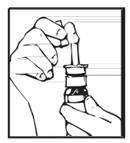
|
| Figure B |
- Press down on the shoulders at the top of your Desmopressin Acetate nasal spray pump 4 times. Hold the spray tip away from your face and eyes (See Figure C).

|
| Figure C |
- After your Desmopressin Acetate nasal spray pump is primed, it will spray 10 micrograms (1 dose) of medicine each time it is pressed.
Using your Desmopressin Acetate nasal spray:
Step 1. Remove the protective cap.
Step 2. To make sure you get the right dose of medicine tilt your Desmopressin Acetate nasal spray pump so the dip tube inside the bottle draws the medicine up from the deepest part of the medicine inside the bottle (See Figures D and E).
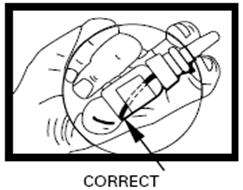
|

|
| Figure D | Figure E |
Step 3. Put the spray nozzle tip of your Desmopressin Acetate nasal spray into your nostril and press the spray pump 1 time for 1 dose. (See Figure F). If 2 doses are prescribed, spray each nostril 1 time.
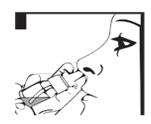
|
| Figure F |
Step 4. Put the protective cap back on the spray nozzle tip when you finish using your Desmopressin Acetate nasal spray.
Keeping track of your nasal sprays:
- Use the check-off chart to help you keep track of your Desmopressin Acetate nasal sprays used (See Figure G).
|
Desmopressin Acetate nasal spray 50-Spray Check-off Chart |
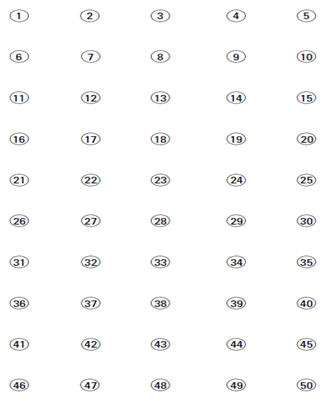
|
| Figure G |
- Keep this chart with your Desmopressin Acetate nasal spray or put it someplace where you can easily get it.
- Check off number 1 on the chart with your first dose of Desmopressin Acetate nasal spray. Check off the numbers after each use of your Desmopressin Acetate nasal spray. If your healthcare provider prescribed a 2-spray dose, then 2 numbers should be checked off.
- Your Desmopressin Acetate nasal spray holds 50 sprays with the right amount of medicine in each spray.
- If any medicine is left in your Desmopressin Acetate nasal spray after 50 sprays, do not use it. You may not get the right amount of medicine.
- Throw away your Desmopressin Acetate nasal spray after 50 sprays.
- Do not count the priming sprays. Your Desmopressin Acetate nasal spray has been filled with extra medicine for your priming sprays.
- Do not try to remove any medicine from your Desmopressin Acetate nasal spray pump and place it in another bottle.
How should I store Desmopressin Acetate nasal spray?
- Store Desmopressin Acetate nasal spray at room temperature between 68°F to 77°F (20°C to 25°C).
- Store Desmopressin Acetate nasal spray standing upright.
This Instructions for Use has been approved by the U.S. Food and Drug Administration.
Manufactured for:
Prasco Laboratories
Mason, OH 45040 USA
6475-01
REV. 10/2013
PRINCIPAL DISPLAY PANEL - 5 mL Bottle Carton
NDC 66993-025-01
PRASCO
Desmopressin
Acetate
Nasal Spray
10 mcg per 0.1 mL
Rx Only
5 mL
(50 sprays)
Attention Pharmacist-
detach patient's
instructions from
package insert and
dispense with spray pump.
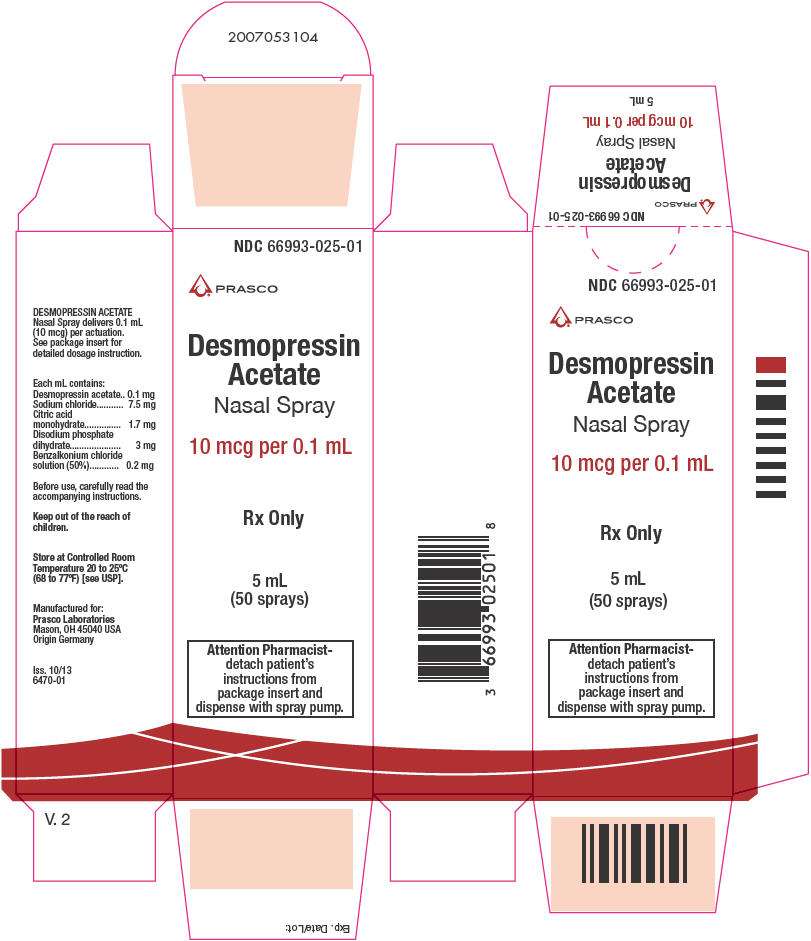
Desmopressin AcetateDESMOPRESSIN ACETATE SPRAY
| |||||||||||||||||||||||||||||||||||||||||||||||||||||||||||||||||||